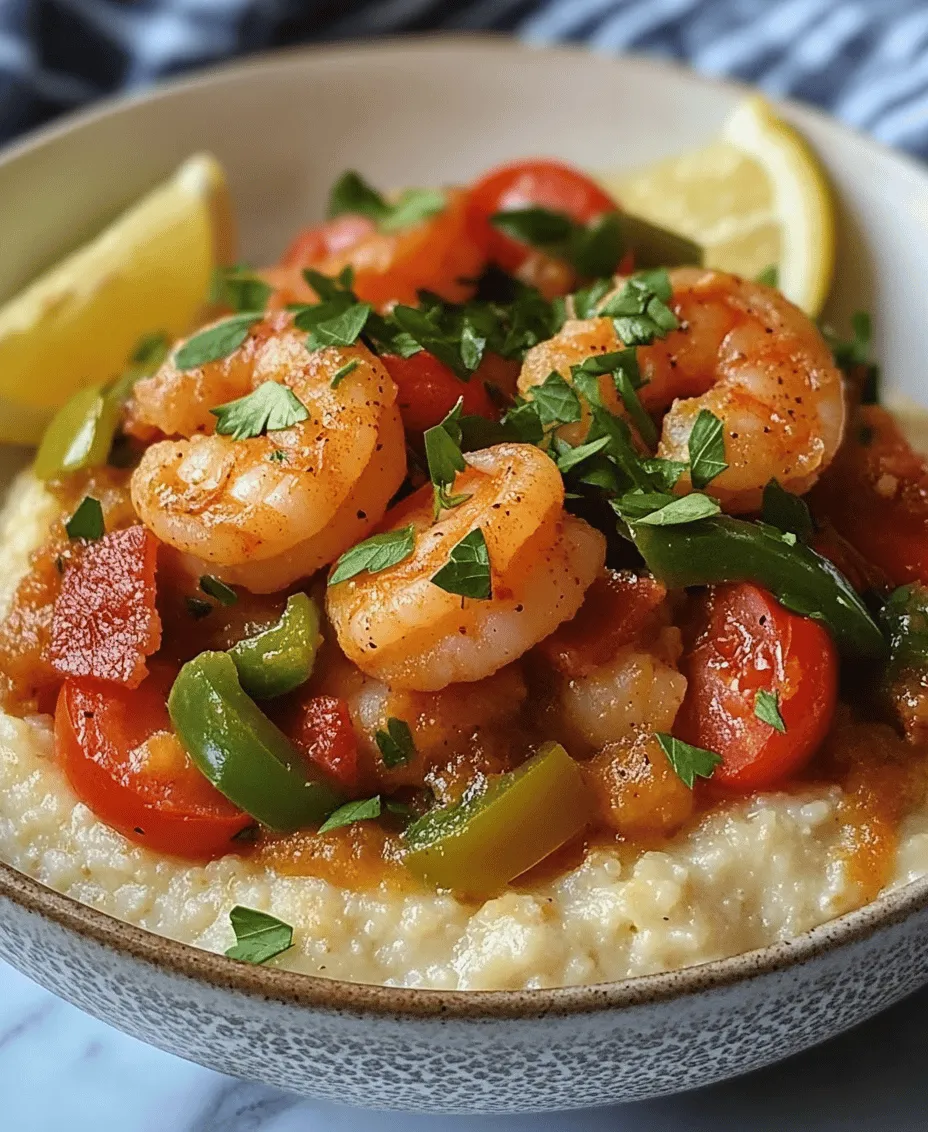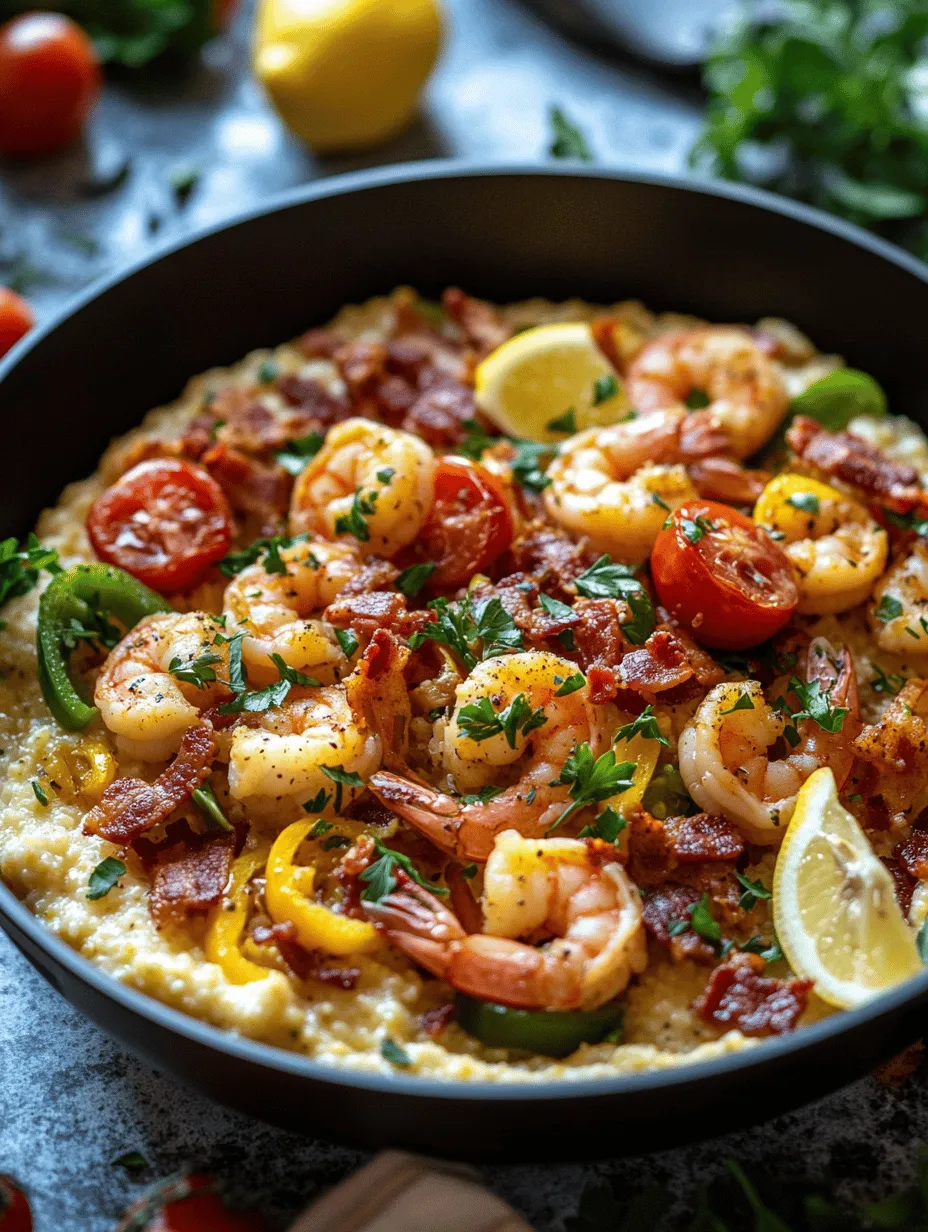Introduction
Southern cuisine is renowned for its rich flavors, hearty portions, and comforting nature. It embodies the essence of hospitality and warmth, often bringing families and friends together around a table filled with indulgent dishes. Among the many culinary treasures of the South, few are as beloved as shrimp and grits—a dish that perfectly captures the spirit of Southern cooking. This classic comfort food features succulent shrimp paired with creamy, buttery grits, making it a satisfying meal that can be enjoyed at any time of day, from breakfast to dinner.
Shrimp and grits is more than just a dish; it is a celebration of the region’s coastal bounty and agricultural heritage. The combination of tender shrimp, smooth grits, and a medley of savory ingredients creates a symphony of flavors and textures that warms the soul. Whether it’s served at a festive gathering or a quiet family dinner, shrimp and grits evokes a sense of comfort and nostalgia that resonates deeply with those who enjoy it.
Understanding Shrimp and Grits
To truly appreciate shrimp and grits, one must delve into its historical context within Southern culture. The roots of this dish can be traced back to the Lowcountry of South Carolina and Georgia, where it originated as a humble breakfast for fishermen. The dish was made from the plentiful shrimp caught along the coast and the locally grown corn used to create grits. Over time, shrimp and grits evolved from a rustic meal to a gourmet favorite, finding its way onto the menus of upscale restaurants while still retaining its comforting essence.
The evolution of shrimp and grits reflects broader trends in Southern cooking, where traditional recipes are reimagined with modern flair. While the original dish consisted of simple ingredients, contemporary variations often include a range of flavorful additions—such as spices, vegetables, and sauces—that enhance the overall experience. At its core, however, shrimp and grits remains a testament to the importance of quality ingredients in achieving an authentic flavor profile.
The Importance of Ingredients
The secret to a truly exceptional shrimp and grits lies in using the best quality ingredients available. Each component plays a vital role in shaping the dish’s distinctive taste. Let’s take a closer look at the key ingredients that make this dish shine:
1. Stone-Ground Grits: The foundation of the dish, stone-ground grits are essential for achieving the right texture and flavor. Unlike instant or quick-cooking grits, stone-ground varieties are minimally processed and retain their natural corn flavor, resulting in a creamy and hearty base.
2. Chicken Broth vs. Water: When cooking grits, the choice between chicken broth and water can significantly impact the flavor. Using chicken broth adds a layer of richness and depth that enhances the overall taste of the dish, making it more savory and satisfying.
3. Heavy Cream and Cheddar Cheese: For a luscious, creamy texture, incorporating heavy cream and cheddar cheese is a must. The creaminess of these dairy products elevates the grits, turning them into a decadent accompaniment that balances the shrimp beautifully.
4. Shrimp: The star of the dish, shrimp should be fresh, high-quality, and preferably sourced from local waters. Depending on your preference, you can use either large shrimp or smaller varieties—both offer a delightful bite.
5. Bacon: Adding bacon introduces a smoky flavor that is quintessential in Southern cooking. The rendered fat from the bacon contributes to the dish’s richness and depth, making it an essential ingredient.
6. Vegetables: Aromatic vegetables such as onion, bell pepper, garlic, and tomatoes add layers of flavor to the dish. These ingredients not only enhance the taste but also provide a colorful and visually appealing presentation.
7. Seasonings: Finally, the right seasonings can make or break the dish. Smoked paprika, Cajun seasoning, and Worcestershire sauce work together to create a bold flavor profile that complements both the shrimp and the creamy grits.
Preparation of the Grits
The preparation of grits is a crucial step in making shrimp and grits, and it requires careful attention to detail to achieve that perfect, velvety consistency. Here’s a step-by-step guide to cooking stone-ground grits to perfection:
Step 1: Gather Your Ingredients
Before you begin, ensure you have all the necessary ingredients at hand. You’ll need stone-ground grits, chicken broth (or water), heavy cream, cheddar cheese, and any additional seasonings you prefer.
Step 2: Boil the Liquid
Begin by bringing your chicken broth to a boil in a medium saucepan. Using broth instead of water will infuse the grits with more flavor right from the start. You can also add a pinch of salt to the broth for an extra layer of seasoning.
Step 3: Gradual Whisking
Once the broth is boiling, reduce the heat to low and slowly whisk in the stone-ground grits. It’s essential to add the grits gradually while whisking continuously to prevent any lumps from forming. This gradual incorporation ensures that the grits cook evenly and achieve a smooth texture.
Step 4: Simmer and Stir
After adding the grits, allow the mixture to simmer gently. Stir frequently to keep the grits from sticking to the bottom of the pan. This step is crucial, as it helps to keep the grits creamy and prevents them from forming a crust.
Step 5: Achieving the Right Consistency
Cook the grits for about 20 to 30 minutes, or until they are tender and creamy. The exact cooking time may vary based on the brand of grits used, so keep an eye on them. The final texture should be thick yet pourable; if the grits become too thick, you can add a little more broth or water to loosen them.
Step 6: Incorporating Dairy
Once the grits are cooked to perfection, stir in the heavy cream and shredded cheddar cheese. This addition will enhance the richness of the grits, making them even more indulgent. Taste and adjust the seasoning as necessary, adding salt and pepper to suit your palate.
Cooking the Shrimp
While the grits are simmering, it’s time to prepare the shrimp. The process is straightforward but requires attention to achieve perfectly cooked shrimp that are tender and flavorful.
1. Preparing the Shrimp: If you’re using shell-on shrimp, make sure to peel and devein them before cooking. Pat the shrimp dry with paper towels to ensure they sear properly.
2. Cooking the Bacon: In a large skillet over medium heat, cook diced bacon until it’s crispy. The rendered fat will be used to cook the shrimp, imparting a delicious smoky flavor.
3. Sautéing Vegetables: After removing the crispy bacon, use the same skillet to sauté chopped onions and bell peppers until they are soft and fragrant. Add minced garlic and cook for an additional minute.
4. Cooking the Shrimp: Next, add the shrimp to the skillet, cooking them until they turn pink and opaque—about 3 to 5 minutes. Season the shrimp with smoked paprika, Cajun seasoning, and a splash of Worcestershire sauce for an added flavor kick.
5. Combining with Grits: Once the shrimp are cooked, you can combine them with the grits, drizzling any residual juices over the top for added flavor.
By following these steps, you’ll create a dish that not only satisfies the palate but also pays homage to the rich culinary traditions of the South. Shrimp and grits is more than just a meal; it’s a cultural experience that brings the warmth of Southern hospitality right to your table.

Detailed Process for Sautéing Shrimp to Perfection
Sautéing shrimp to perfection is an art that requires attention to detail and timing. To start, ensure your shrimp are fresh or properly thawed if previously frozen. Pat them dry with a paper towel to remove excess moisture; this will help achieve a nice sear.
1. Heat the Pan: Begin by placing a large skillet over medium-high heat. Add a generous tablespoon of bacon fat. This fat not only imparts a rich flavor but also helps in achieving that sought-after golden crust on the shrimp.
2. Add the Shrimp: Once the bacon fat is hot but not smoking, carefully add the shrimp in a single layer. Avoid overcrowding the pan, as this can cause the shrimp to steam rather than sauté.
3. Seasoning: Season the shrimp lightly with salt and freshly cracked black pepper. You can also add a sprinkle of garlic powder or paprika for an extra flavor kick. Cook the shrimp for about 2-3 minutes on one side. You’ll know they are ready to flip when they turn opaque and start curling slightly.
4. Flip and Finish: Flip the shrimp and cook for another 1-2 minutes on the other side. The shrimp should be bright pink and firm to the touch. Remember to remove them from the heat as soon as they reach this stage to avoid overcooking.
5. Importance of Bacon Fat for Flavor: The use of bacon fat is a quintessential aspect of Southern cooking. It adds a richness that elevates the dish. Beyond flavor, bacon fat helps to create a beautiful caramelization on the shrimp, making them not only delicious but visually appealing.
Techniques for Sautéing Vegetables: Timing and Order of Ingredients
When it comes to sautéing the accompanying vegetables, timing is crucial for achieving the perfect texture and flavor balance:
1. Start with Aromatics: Begin by adding onions and garlic to the hot bacon fat left in the skillet after cooking the shrimp. Sauté these for about 2-3 minutes until translucent and fragrant.
2. Add Bell Peppers: Next, toss in diced bell peppers. They take a bit longer to cook than onions or garlic, so allow them to sauté for about 4-5 minutes until they soften.
3. Incorporate Other Vegetables: If you’re adding additional vegetables like spinach or tomatoes, add them last. These tend to cook quickly and can be added just before you combine everything back into the skillet.
4. Seasoning: Don’t forget to season the vegetables as you go. A pinch of salt and pepper will help bring out their natural flavors. For a little extra kick, consider adding a dash of hot sauce or a sprinkle of cayenne pepper.
How to Season Shrimp Correctly for Maximum Flavor
Proper seasoning is key to making your shrimp shine in this dish. Here are some techniques:
1. Balanced Seasoning: Besides salt and pepper, consider using a blend of spices that complements the shrimp. A mix of smoked paprika, garlic powder, and cayenne can add depth without overwhelming the natural sweetness of the shrimp.
2. Marinating: For added flavor, marinate the shrimp for 15-30 minutes in a mixture of olive oil, lemon juice, and your choice of seasonings. This not only enhances flavor but also helps to tenderize the shrimp.
3. Finishing Touches: After cooking, a squeeze of fresh lemon juice over the shrimp serves to brighten the dish and enhances the overall flavor profile.
Cooking Times and Visual Cues for Determining Doneness
Understanding when shrimp are fully cooked is essential. Here are some visual cues:
– Color Change: Raw shrimp are typically gray. As they cook, they will turn a vibrant pink.
– Curling: Cooked shrimp will curl slightly; this is a natural reaction as they tighten up.
– Firmness: The shrimp should feel firm to the touch and opaque in the center. Undercooking slightly is better than overcooking, as shrimp will continue to cook even after being removed from the heat.
Assembly of the Dish
Once everything is cooked, it’s time to assemble your shrimp and grits:
1. Plating Shrimp and Grits Attractively: Start with a generous scoop of creamy grits at the center of your plate. Using the back of a spoon, create a slight well in the middle to hold the shrimp and vegetables.
2. Add the Shrimp: Carefully spoon the sautéed shrimp and vegetable mixture over the grits. Arrange them so that the shrimp are prominently displayed.
3. Garnishing: For an appealing finish, sprinkle crispy bacon bits over the top and add freshly chopped parsley for a pop of color.
4. The Role of Lemon Wedges: Serve with lemon wedges on the side. A squeeze of lemon just before eating can amplify the flavors and add a refreshing contrast to the richness of the dish.
Serving Suggestions
Shrimp and grits is a versatile dish that suits various occasions:
– Family Gatherings: This dish is perfect for family brunches or dinners, bringing everyone together over comforting flavors.
– Special Occasions: Consider serving shrimp and grits for holidays or celebrations, as it’s a crowd-pleaser that can impress guests.
– Wine Pairings: To complement the richness of shrimp and grits, a crisp white wine like Sauvignon Blanc or a light-bodied red such as Pinot Noir works wonderfully. For non-alcoholic options, consider a refreshing iced tea or lemonade.
Variations for Dietary Preferences
Shrimp and grits can easily be adapted for various dietary needs:
1. Gluten-Free: The recipe is naturally gluten-free if you use gluten-free grits. Just ensure that any added seasonings or sauces are gluten-free as well.
2. Dairy-Free: For a dairy-free version, substitute regular milk or cream in the grits with coconut milk or almond milk to maintain creaminess without the dairy.
3. Vegan Options: For a vegan twist, consider using sautéed mushrooms or tofu in place of shrimp. The flavor profile can be enhanced with smoked paprika and liquid smoke to mimic the taste of shrimp.
Nutritional Information
Understanding the nutritional content of shrimp and grits can help you enjoy this dish while being mindful of your health:
– Nutritional Overview: A typical serving of shrimp and grits offers a balanced profile, with shrimp providing protein, while grits contribute carbohydrates.
– Protein Content: Shrimp are an excellent source of lean protein, which is essential for muscle repair and overall health.
– Fats and Carbohydrates: The dish contains healthy fats from the bacon and a moderate amount of carbohydrates from the grits. Consider portion sizes if you’re watching your caloric intake.
Cultural Significance and Variations
Shrimp and grits have deep roots in Southern culinary tradition:
1. Regional Variations: Different Southern states have their own takes on the dish. In Charleston, for example, it may be served with a rich sauce, while in New Orleans, it might incorporate Cajun spices and andouille sausage.
2. Cultural Influences: Similar ingredients appear in various cuisines worldwide. For instance, in Latin America, you might find shrimp served over a corn-based dish akin to grits, showcasing how cultures adapt similar ingredients.
3. Modern Twists: Contemporary chefs are experimenting with this classic dish, incorporating global flavors such as curry spices or serving it with a coconut-based sauce for a tropical flair.
Conclusion
Shrimp and grits is more than just a meal; it’s a heartfelt connection to Southern culinary traditions, rich in flavor and comfort. The combination of succulent shrimp, creamy grits, and savory spices creates a dish that speaks to the soul.
Encouraging readers to delve into this recipe is an invitation to celebrate the joy of cooking and the satisfaction of sharing meals with family and friends. As you cook this dish, you’ll not only enjoy the delicious results but also create a cherished experience that reflects Southern hospitality. So gather your ingredients, embrace the process, and enjoy a taste of tradition on your table.

